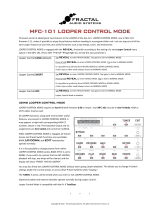
8
1. Main Display This large color LCD is your window into the power of Helix LT.
2. PRESET Turn this knob to select a preset. Press the knob to open the Setlist
menu. See “Selecting Presets and Setlists”
3. SAVE Press this button to rename and save changes to a preset.
4. Press this button to dive a bit deeper into Helix LT, and you’ll find Command
Center, Global EQ, Global Settings, and other menus.
5. If you ever get lost, press this button to return to the main Home screen. Press
again to toggle between the two main Home views - see “Home > Performance
View” and “Home > Signal Flow View”
6.
Press this button once, or multiple times, to quickly jump to the tonestack
parameters (Gain, Bass, Mid, Treble, etc.) of any Amp+Cab, Amp, and Preamp
models in the current preset.
7. Joystick Move the joystick to navigate the main display. On the Home screen,
move the joystick to select a block. Press ACTION and move the joystick to move
the selected block. Turn the joystick to change the selected block’s model. Press the
joystick to open the model list. Press and turn the joystick to quickly scroll across
the signal flow. Yeah, the joystick does a lot.
8. BYPASS Press this button to turn the selected block on and off.
SHORTCUT: Press and hold BYPASS to turn Global EQ on ( icon appears in the
upper right corner of the LCD) and off.
9. ACTION Press this button to open the action panel for the selected block or
screen. From the Home > Signal Flow screen, the action panel lets you move, copy,
paste, and clear blocks, as well as add any changes you’ve made to a block as a
Favorite or save current settings as the model’s default. Other screens may have
unique action panels; for example, the Global Settings action panel lets you reset
all global settings at once.
10.
<PAGE/PAGE> If the selected block or item has more than one page of parameters,
press < PAGE or PAGE > to view more parameters—also see “Selecting Blocks/
Adjusting Parameters”
11.
Knobs 1-6
Turn one of the six knobs below the main display to adjust the param-
eter’s value above; press the knob to reset the parameter’s value. If a rectangular
button appears above a knob, press the knob to engage its function.
SHORTCUT: For most time-based parameters such as delay time or modulation speed,
press the knob to toggle between setting the value in ms or Hz and note divisions (1/4-
note, dotted 1/8-note, etc.).
SHORTCUT: Controllers can be assigned to most parameters. Press and hold a
parameter’s knob to quickly jump to the “Controller Assign” page for that parameter.
12. VOLUME Turn this knob to control the main output and headphones volume.
13. EXP 1/2 LEDs These tell you whether the built-in expression pedal is acting
as EXP 1 (red) or EXP 2 (green).
14. Footswitches The capacitive, touch-sensitive footswitches have colored LED
rings that inform you of the assigned block or item's current state. While in Stomp
footswitch mode, touch (but don’t press) a footswitch to quickly select the assigned
block or item. Touch the switch repeatedly to cycle through multiple assigned items.
See “Stomp Footswitch Mode”
SHORTCUT: While in Stomp footswitch mode, touch (but don’t press) a footswitch for
two seconds to create a Bypass Assignment for the selected block.
SHORTCUT: While in Stomp footswitch mode, touch and hold (but don’t press) two
switches to swap all assignments between them (including any custom names or
LED colors).
SHORTCUT: Touch (but don’t press) TAP to display the tempo panel briefly. This lets
you quickly fine-tune the current tempo without navigating to the Global Settings >
MIDI/Tempo menu.
NOTE: Touch-to-select can optionally be turned off, and other footswitch settings
customized - See “Global Settings > Footswitches”
15. Expression Pedal Move the expression pedal to control volume, wah, or a
combination of amp and/or effects parameters. Activate the hidden toe switch to
toggle between EXP 1 and EXP 2. (The LEDs above tell you which one is active.) If an
external pedal is connected to the rear panel EXP 2 jack, the built-in pedal becomes
EXP 1 only. See “Controller Assign”
NOTE: Adding a Wah, Pitch Wham, or Poly Wham block automatically assigns its
Position parameter to be controlled by EXP 1. Adding a Volume Pedal or Pan block
automatically assigns its Position to be controlled by EXP 2.





















